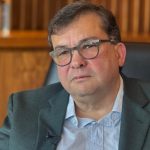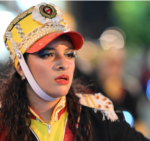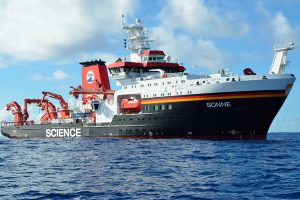On January 18, the port of Talcahuano will receive one of the most modern and best equipped research vessels in the world. It is the German scientific vessel RV SONNE, in which more than 50 scientists from Chile and Germany will embark. The objective?: to study the low-oxygen areas on the coasts of the Biobío Region and the Almirante Montt Gulf in the Region of Magallanes and Antarctica Chile.
Researchers from the COPAS Coastal Center of the University of Concepción, the Millennium Institute of Oceanography, IMO, the Austral University, the U. Federico Santa María, the Leibniz Institute for Baltic Sea Research in Germany and other German institutions participate in the expedition. and Chilean.
Dr. Heide Schulz-Vogt, an academic at the Leibniz Institute for Baltic Sea Research in Germany is the cruise’s chief scientist and Dr. Silvio Pantoja, deputy director of the COPAS Center is the national coordinator of the campaign, in which a multidisciplinary work to know the impact of pelagic anoxia in the outcrop off Concepción and in a pristine anoxic fjord, such as the Almirante Montt Gulf, in addition to investigating the postglacial development of the Patagonian fjord region of our country.
With a total of 30 working days, the researchers will carry out studies in marine biogeochemistry, paleoclimatology, marine organic and inorganic chemistry, bio-optics, marine microbial ecology, and ecophysiology.
It may interest you: Call 2023: we are looking for scientists who want to be part of the popularization book 100 scientific illustrations
“SONNE is the newest ship in Germany to develop oceanography and we have been planning to study these areas with professionals from the U. de Concepción and other institutions for a long time.
We want to study these places because anoxia increases with climate change, which happens a lot in areas like these where there is primary production, but it is also the case of the Baltic Sea, for example, because many nutrients arrive here with the rivers and high agriculture around.
We also want to study the Almirante Montt Gulf, which is “more enclosed”, more similar to the Baltic Sea, but smaller and with less agriculture around it; That is why it seems important to us to make a comparison between these areas”, says Dr. Heide Schulz-Vogt.
Touring the Biobío Region and Patagonia
Since the great oxygenation event approximately 2.3 billion years ago, oxygen has shaped our planet and interacts with all the major elemental cycles: the nitrogen, sulfur, and phosphorus cycle, and most importantly, life itself and the carbon cycle depend directly on the availability of oxygen, which has changed considerably in the geological past, detecting areas of low concentrations, whose effects have not been sufficiently investigated.
With this background and considering the fact that oxygen deficiency in the global ocean is expected to expand geographically as the Anthropocene progresses, it becomes relevant to carry out this expedition and for this, the ship SONNE will set sail from the port of Talcahuano on January 21, the day on which the scientific campaign “Impact of pelagic anoxia in the upwelling area off Concepción and in a pristine anoxic fjord, and the postglacial development of the Patagonian fjord region of Chile” will begin. (“Impact of pelagic Anoxia in the Upwelling Area off Concepción and in a pristine anoxic Fjord, and the postglacial Development of the Patagonian Fjord Region of Chile”) by Bahía de Concepción, where 27 sampling stations will be carried out, work that includes hauls of networks to obtain samples and images of zoo and phytoplankton species, water and sediment sampling, as well as measurements of oceanographic variables to later end up in the same mo port on January 28, thus fulfilling the first area of work.
“By investigating this area we want to fill specific knowledge gaps on the impact of the oxygen minimum zone on organic and inorganic geochemistry, microbiology, food webs and diversity… the idea is to compare this area with other little-known areas of the fjords that They are systems that should not present anoxia because they are environments close to freshwater flows, but nevertheless have this condition. We will study the physical and biological phenomena that dominate for this to be happening”, explains Cristóbal Castillo, a marine biologist who will embark on all stages of the campaign and who is currently doing a doctorate at the COPAS Coastal Center.
On January 29, the ship sets sail again, but this time towards the Magallanes Region, where a second and third area will be studied. The Almirante Montt Gulf (GAM) presents conditions of hypoxia and anoxia (low and zero oxygen levels) that make it a research point to determine the causes and conditions of that characteristic. It is a presumably pristine environment which will be compared with environments strongly affected by human activity (Baltic Sea, Black Sea) and the geological history of this fjord system will be reconstructed. In addition, the Canal Concepción, Wide and Seno Eyre fjords will be studied.
In this last aspect, in the area of paleoceanography is Dr. Carina Lange, a researcher at the COPAS center, who explains that “we will study the accumulated sediments in the Almirante Montt Gulf and in the Concepción channel, in the area of the Patagonian fjords . At time scales of the last 200 years, we will study the recent hydrological and biological changes that have occurred in these fjords due to climate change. To do this, we will use various chemical, sedimentological parameters and biomarkers preserved in the sediments and we will also use them to reconstruct changes in, for example, productivity, oxygenation, changes in sea level, etc. on longer time scales such as, for example, during the last 18,000-20,000 years. The latter will give us a historical view of natural changes in the fjords before human impact.”
In these areas, the researchers will obtain images of the zoo and phytoplankton and take sediment samples, and the oceanography of this environment will be described in detail to make a stopover once the work is finished in the port of Talcahuano on February 21.
About the SONNE scientific vessel
This campaign using the scientific vessel SONNE arises from a scientific cooperation agreement between the University of Concepción and the Leibniz Institute for Baltic Sea Research in Warnemünde, Germany. “This is the fruit of a long-standing collaboration between Chile and the German group of scientists led by Heide Schultz. SONNE is a large vessel that allows studying the sediment, water column and atmosphere at the same time, so our approach is comprehensive; we are very happy that we can finally receive it in Chilean waters”, comments the director of COPAS Coastal, Dr. Camila Fernández.
The SONNE measures 116 meters long and 20.6 meters wide, was undocked and carried out its first tests in the North and Baltic seas in 2014, being described as a “floating miracle” in the words of Angela Merkel.
Particularly noteworthy are the engine room units, which are mounted in such a way that they hardly send vibrations into the ship’s hull. This means that SONNE can travel quietly and vibration-free to avoid annoying echo surveys. The deep-sea research vessel also has seven high-performance cranes, a diving robot and a precise positioning system. The ship is held exactly in place during research operations by its two large propellers, rotating pump jet and bow and stern thruster.
But it is not the first time that SONNE has carried out research in the Chilean sea, since, at the beginning of 2022, scientists embarked to study the sea floor in the South Pacific, traveling from Valparaíso (Chile) to Noumea (New Caledonia).
SONNE has capacity for 40 scientists, a crew of 32 people and 17 laboratories in 600 m2.












